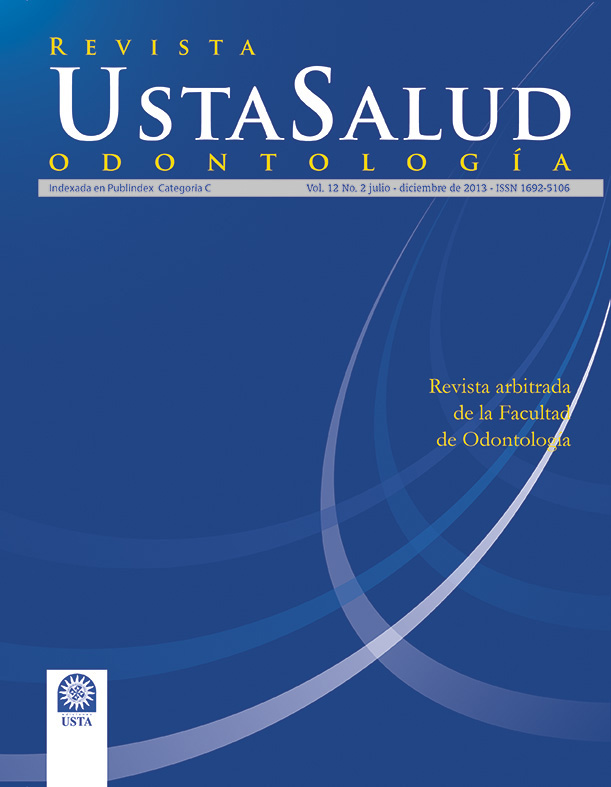INFLUENCIA DE LA DISTANCIA ENTRE LA CRESTA ÓSEA Y EL PUNTO DE CONTACTO INTERDENTAL EN LA FORMACIÓN DE PAPILAS GINGIVALES: ESTUDIO EN PERROS
Resumen
Objetivo: evaluar la influencia de la distancia entre la cresta ósea y el punto de contacto interdental (3 y 5 mm) y la distancia entre implantes (2 y 3 mm) en la formación de papilas gingivales.
Materiales y métodos: ocho perros adultos jóvenes fueron seleccionados para el estudio. Se realizaron las exodoncias de los cuatro premolares inferiores de cada hemiarcada mandibular y después de tres meses se colocaron tres implantes dentales (4,3 x 10 mm) en cada hemiarcada. El primer implante fue puesto a 10 mm del canino remanente, el segundo (intermedio) fue colocado a 2 mm del primero y el tercero a 3 mm del segundo. Las coronas metálicas definitivas fueron confeccionadas con distancias de 3 y 5 mm entre la cresta ósea y el punto de contacto interdental. Se evaluaron clínicamente doce semanas después de la instalación de las prótesis para medir el espacio formado entre la papila y el punto de contacto y luego estos datos fueron analizados estadísticamente mediante el Análisis de Varianza (ANOVA) de dos vías y la prueba de Bonferroni. Se consideró un valor de p<0,05 como estadísticamente significativo.
Resultados: se encontró un espacio mayor en los lugares en que la distancia entre implantes era de 2 mm y la altura del punto de contacto de 5 mm. El menor se obsevó en los sitios en que la distancia entre implantes era de 2 mm y altura del punto de contacto 3 mm.
Conclusión: los puntos de contacto de 3 mm influyen positivamente en la formación de las papilas gingivales.
[Cruvinel DR, Alandia-Román CC, Villabona CA, Muglia VA. Influencia de la distancia entre la cresta ósea y el punto de contacto interdental en la formación de papilas gingivales: estudio en perros. Ustasalud 2013; 12: 101 - 107]
Referencias
2. Choquet V, Hermans M, Adriaenssens P, Daelemans P, Tarnow DP, Malevez C. Clinical and radiographic evaluation of the papilla level adjacent to single-tooth dental implants. A retrospective study in the maxillary anterior region. J Periodontol 2001; 72: 1364 – 1371.
3. Belser U, Buser D, Higginbottom F. Consensus statements and recommended clinical procedures regarding esthetics in implant dentistry. Int J Oral Maxillofac Implants 2004; 19 Suppl: 73 – 74.
4. Tarnow DP, Cho SC, Wallace SS. The effect of inter-implant distance on the height of inter-implant bone crest. J Periodontol 2000; 71: 546 - 549.
5. Cappiello M, Luongo R, Di Lorio D, Bugea C, Cocchetto R, Celletti R. Evaluation of peri-implant bone loss around platform-switched implants. Int J Periodontics Restorative Dent 2008; 28: 347 - 355.
6. Oh TJ, Yoon J, Mishc CE, Wang HL. The causes of early implant bone loss: Myth or since? J Periodontol 2002; 73: 322 – 333.
7. Morris HF, Ochi S, Crum P, Orenstein IH, Winkler S. AICRG, part I: a 6-year multicentered, multidisciplinary clinical study of a new and innovative implant design. J Oral Implantol 2004; 30: 125 – 133.
8. Buser D, Weber HP, Donath K, Fiorelline JP, Paquette DW, Williams RC. Soft tissue reactions to nom-submerged unloaded titanium implants in beagle dogs. J Periodontol 1992; 63: 226 - 236.
9. Tarnow DP, Magner AW, Flecther P. The effect of the distance from the contact point to the crest of bone on the presence or absence of the interproximal dental papilla. J Periodontol 1992; 63: 995 – 996.
10. Gastaldo JF, Cury PR, Sendyk R. Effect of the vertical and horizontal distances between adjacent implants and between a tooth and implants on the incidence of interproximal papilla. J Periodontol 2004; 75: 1242 – 1246.
11. Scarano A, Assenza B, Piattelli M, Thams U, Roman FS, Favero GA. Interimplant distance and crestal bone resorption: a histologic study in the canine mandible. Clin Implant Dent Related Res 2004; 6: 150 – 156.
12. Novaes Jr AB, Vidigal Jr GM, Novaes AB, Grisi MFM, Polloni S, Rosa A. Immediate implants placed into infected sites: A histomorfometric study in dogs. Int J Oral Maxillofac Implants 1998; 13: 113 – 118.
13. Adell R, Eriksson B, Lekholm U, Branemark PI, Jemt T. Long-term follow-up study of osseointegrated implants in the treatment of totally edentulous jaws. Int J Oral Maxillofac Implants 1990; 5: 347 – 349.
14. Schwartz-Arad D, Chaushu, G. Placement of implants into fresh extraction sites: 4 to 7 years retrospective evaluation of 95 immediate implants. J Periodontol 1997; 68: 1110 – 1116.
15. Friberg B, Jemt T, Lekholm U. Early failures in 4,641 consecutively placed Branemark dental implants: a study from stage 1 surgery to the connection of completed prostheses. Int. J Oral Maxillofac Implants 1991; 6: 142 – 146.
16. Silverstein L, Garg A, Callan D, Shatz P. The key to success: maintaining the long-term health of implants. Dent Today 1998; 17: 104 – 111.
17. Hermann JS, Cochran DL, Nummikoski PV, Buser D. Crestal bone changes around titanium implants. A radiographic evaluation of unloaded non-sumerged implants in the canine mandible. J Periodontol 1997; 68: 1117 – 1130.
18. Papalexiou V, Novaes Jr, AB, Ribeiro RF, Muglia VA, Oliveira RR. Influence of the interimplant distance on crestal bone resorption and bone density: A histomorphometric study in dogs. J Periodontol 2006; 77: 614 – 621.
19. Novaes Jr, AB, Barros RRM, Muglia VA, Borge GJ. Influence of interimplant distances and placement depth on papilla formation and crestal resorption: a clinical and radiographic study in dogs. J Oral Implantol 2009; 35: 18 – 27.















